Phantom Rows
The phantom reads anomaly is a special case of Non-repeatable reads when Transaction 1 repeats a ranged SELECT ... WHERE query and, between both operations, Transaction 2 creates new rows (i.e., INSERT) or deletes existing rows (i.e., DELETE) (in the target table) which fulfill that WHERE clause.
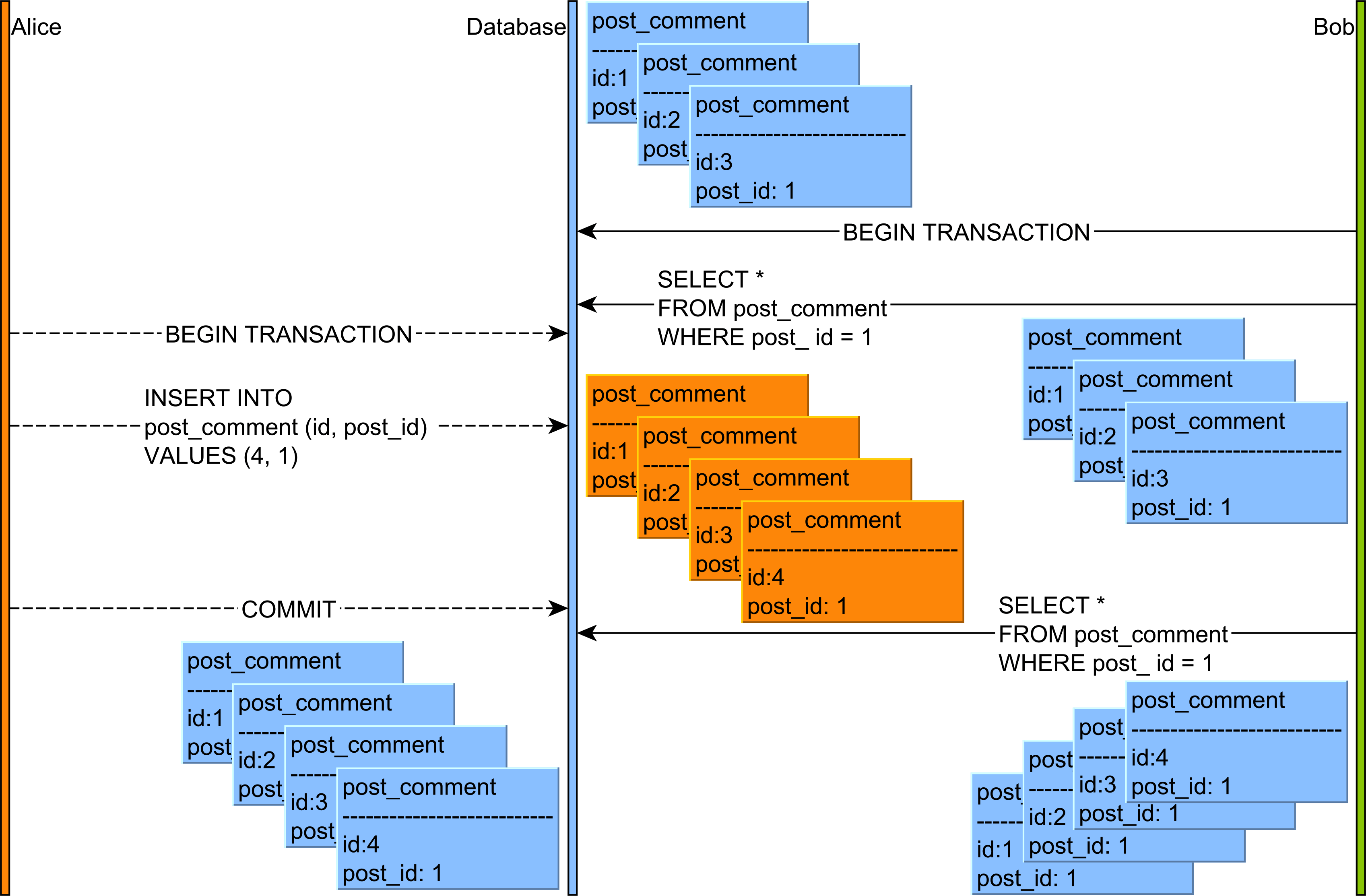
In the diagram above, the flow of statements goes like this:
- Alice and Bob start two database transactions.
- Bob’s reads all the
post_commentrecords associated with thepostrow with the identifier value of 1. - Alice adds a new
post_commentrecord which is associated with thepostrow having the identifier value of 1. - Alice commits her database transaction.
- If Bob’s re-reads the
post_commentrecords having thepost_idcolumn value equal to 1, he will observe a different version of this result set.
How to aviod Phantom Reads
If the highest level of isolation (i.e., SERIALIZABLE isolation level) were maintained, the same set of rows should be returned both times, and indeed that is what is mandated to occur in a database operating at the SERIALIZABLE isolation level. However, at the lesser isolation levels, a different set of rows may be returned the second time.
In the SERIALIZABLE isolation mode, Query 1 would result in all records with post_id =1 being locked, thus Query 2 would block until the first transaction was committed. In REPEATABLE READ mode, the range would not be locked, allowing the record to be inserted and the second execution of Query 1 to include the new row in its results.
How to prevent:
The 2PL-based Serializable isolation prevents Phantom Reads through the use of predicate locking while MVCC (Multi-Version Concurrency Control) database engines address the Phantom Read anomaly by returning consistent snapshots.
However, a concurrent transaction can still modify the range of records that was read previously. Even if the MVCC database engine introspects the transaction schedule, the outcome is not always the same as a 2PL-based implementation. One such example is when the second transaction issues an insert without reading the same range of records as the first transaction. In this particular use case, some MVCC database engines will not end up rolling back the first transaction.
MySQL 是怎么解决幻读的?
MySQL InnoDB 引擎的默认隔离级别虽然是「可重复读」,但是它很大程度上避免幻读现象(并不是完全解决了,下面会聊),解决的方案有两种:
- 针对快照读(普通 select 语句),是通过 MVCC 方式解决了幻读,因为可重复读隔离级别下,事务执行过程中看到的数据,一直跟这个事务启动时看到的数据是一致的,即使中途有其他事务插入了一条数据,是查询不出来这条数据的,所以就很好了避免幻读问题。
- 针对当前读(select … for update 等语句),是通过 next-key lock(记录锁+间隙锁)方式解决了幻读,因为当执行 select … for update 语句的时候,会加上 next-key lock,如果有其他事务在 next-key lock 锁范围内插入了一条记录,那么这个插入语句就会被阻塞,无法成功插入,所以就很好了避免幻读问题。
快照读时,如何避免幻读的?
可重复读隔离级是由 MVCC(多版本并发控制)实现的,实现的方式是开始事务后(执行 begin 语句后),在执行第一个查询语句后,会创建一个 Read View,后续的查询语句利用这个 Read View,通过这个 Read View 就可以在 undo log 版本链找到事务开始时的数据,所以事务过程中每次查询的数据都是一样的,即使中途有其他事务插入了新纪录,是查询不出来这条数据的,所以就很好了避免幻读问题。
做个实验,数据库表 t_stu 如下,其中 id 为主键。
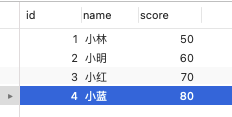
然后在可重复读隔离级别下,有两个事务的执行顺序如下:
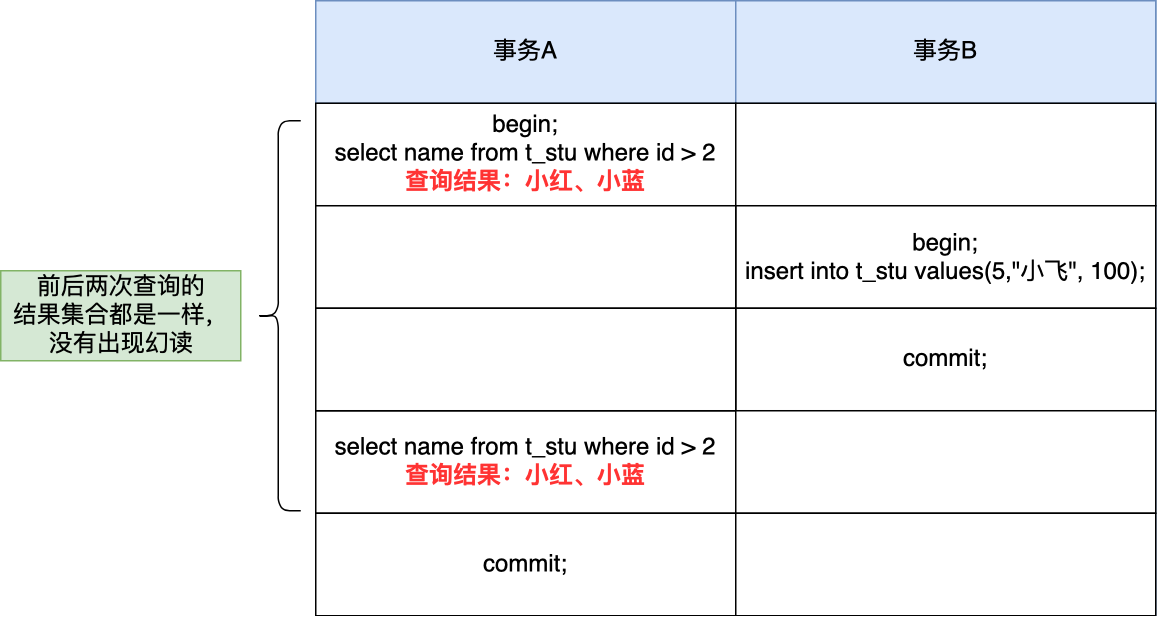
从这个实验结果可以看到,即使事务 B 中途插入了一条记录,事务 A 前后两次查询的结果集都是一样的,并没有出现所谓的幻读现象。
当前读时,如何避免幻读的?
MySQL 里除了普通查询是快照读,其他都是当前读,比如 update、insert、delete,这些语句执行前都会查询最新版本的数据,然后再做进一步的操作。
这很好理解,假设你要 update 一个记录,另一个事务已经 delete 这条记录并且提交事务了,这样不是会产生冲突吗,所以 update 的时候肯定要知道最新的数据。
另外,select ... for update 这种查询语句是当前读,每次执行的时候都是读取最新的数据。
接下来,我们假设select ... for update当前读是不会加锁的(实际上是会加锁的),再做一遍实验。
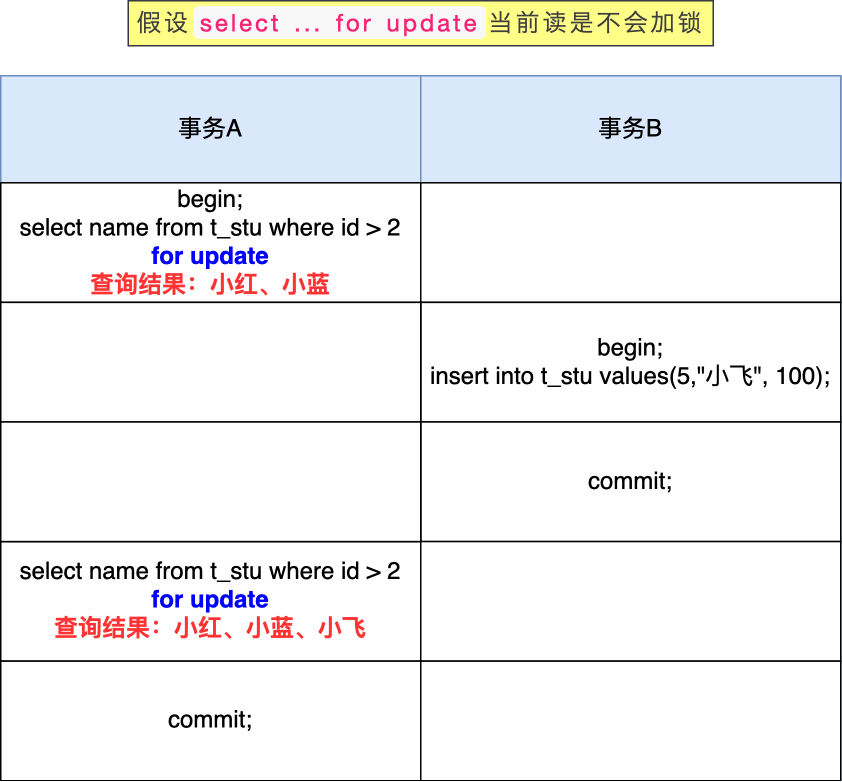
这时候,事务 B 插入的记录,就会被事务 A 的第二条查询语句查询到(因为是当前读),这样就会出现前后两次查询的结果集合不一样,这就出现了幻读。
所以,Innodb 引擎为了解决「可重复读」隔离级别使用「当前读」而造成的幻读问题,就引出了间隙锁。
假设,表中有一个范围 id 为(3,5)间隙锁,那么其他事务就无法插入 id = 4 这条记录了,这样就有效的防止幻读现象的发生。
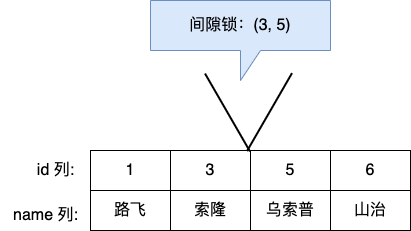
举个具体例子,场景如下:
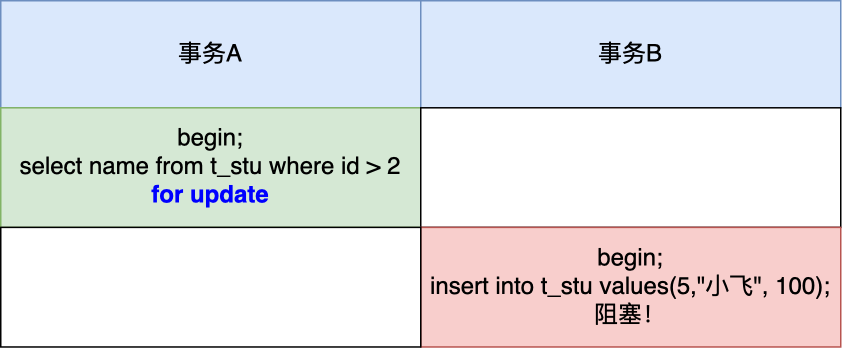
事务 A 执行了这面这条锁定读语句后,就在对表中的记录加上 id 范围为 (2, +∞] 的 next-key lock(next-key lock 是间隙锁+记录锁的组合)。
然后,事务 B 在执行插入语句的时候,判断到插入的位置被事务 A 加了 next-key lock,于是事物 B 会生成一个插入意向锁,同时进入等待状态,直到事务 A 提交了事务。这就避免了由于事务 B 插入新记录而导致事务 A 发生幻读的现象。
幻读被完全解决了吗?
【可重复读隔离级别】下虽然很大程度上避免了幻读,但是还是没有能完全解决幻读。
我举例一个【可重复读隔离级别】发生幻读现象的场景。
Scenario 1 - 发生幻读现象
还是以这张表作为例子:
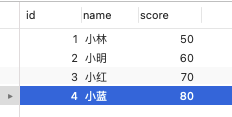
事务 A 执行查询 id = 5 的记录,此时表中是没有该记录的,所以查询不出来。
# 事务 A
mysql> begin;
Query OK, 0 rows affected (0.00 sec)
mysql> select * from t_stu where id = 5;
Empty set (0.01 sec)
然后事务 B 插入一条 id = 5 的记录,并且提交了事务。
# 事务 B
mysql> begin;
Query OK, 0 rows affected (0.00 sec)
mysql> insert into t_stu values(5, '小美', 18);
Query OK, 1 row affected (0.00 sec)
mysql> commit;
Query OK, 0 rows affected (0.00 sec)
此时,事务 A 更新 id = 5 这条记录。
可以看到,事务 A 在第一次查询时,查不到 id = 5 这条记录。但是事务 A 更新了这条记录后,再次查询 id = 5 的记录,事务 A 就能看到事务 B 插入的纪录了(能查询到 id = 5的记录 age 为 18),幻读就是发生在这种违和的场景。
# 事务 A
mysql> update t_stu set name = '小林coding' where id = 5;
Query OK, 1 row affected (0.01 sec)
Rows matched: 1 Changed: 1 Warnings: 0
mysql> select * from t_stu where id = 5;
+----+--------------+------+
| id | name | age |
+----+--------------+------+
| 5 | 小林coding | 18 |
+----+--------------+------+
1 row in set (0.00 sec)
整个发生幻读的时序图如下:
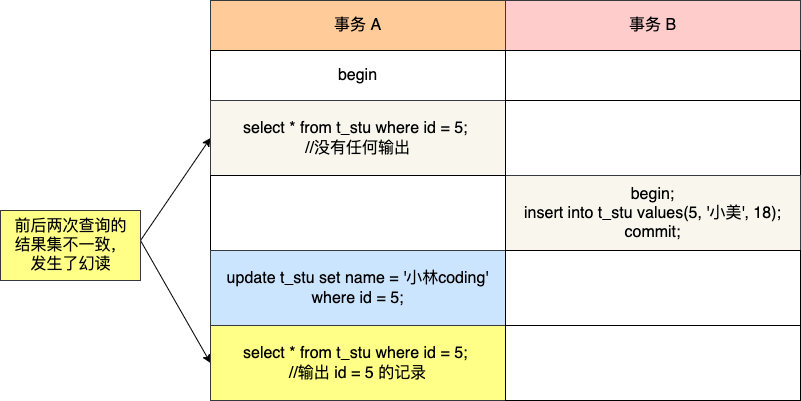
在可重复读隔离级别下,事务 A 第一次执行普通的 select 语句时生成了一个 ReadView,之后事务 B 向表中新插入了一条 id = 5 的记录并提交。接着,事务 A 对 id = 5 这条记录进行了更新操作,在这个时刻,这条新记录的 trx_id 隐藏列的值就变成了事务 A 的事务 id,之后事务 A 再使用普通 select 语句去查询这条记录时就可以看到这条记录了,于是就发生了幻读。
因为这种特殊现象的存在,所以我们认为 MySQL Innodb 中的 MVCC 并不能完全避免幻读现象。
Scenario 2 - 发生幻读现象
除了上面这一种场景会发生幻读现象之外,还有下面这个场景也会发生幻读现象。
- T1 时刻:事务 A 先执行「快照读语句」:select * from t_test where id > 100 得到了 3 条记录。
- T2 时刻:事务 B 往插入一个 id= 200 的记录并提交;
- T3 时刻:事务 A 再执行「当前读语句」 select * from t_test where id > 100 for update 就会得到 4 条记录,此时也发生了幻读现象。
要避免这类特殊场景下发生幻读的现象的话,就是尽量在开启事务之后,马上执行 select … for update 这类当前读的语句,因为它会对记录加 next-key lock,从而避免其他事务插入一条新记录。
Reference
- https://dev.mysql.com/doc/refman/8.0/en/innodb-next-key-locking.html
- https://xiaolincoding.com/mysql/transaction/phantom.html
- https://xiaolincoding.com/mysql/lock/lock_phantom.html
- https://stackoverflow.com/questions/5444915/how-to-produce-phantom-read-in-repeatable-read-mysql